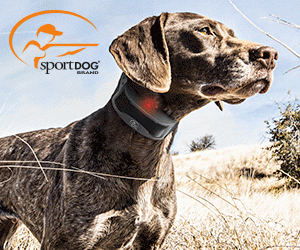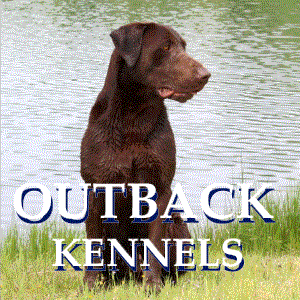Tails We Could Wag
Fly the Flag Breed myopic bird doggers won’t own a dog without a tail. The dog’s tail is like a talisman, an object that we believe has magic powers and can bring good luck. That luck comes when a pointer or setter goes on point and his tail flies high. Some favor a 12 o’Clock tail, while traditionalists prefer the tail as an extension of the dog’s spine. Others like it in between but the point is all the same: get up on that point ‘cause your dog pinned a bird.

Dogs use their tails to communicate other information. If his tail locks up and then starts to wag it’s called flagging. Your pup is probably saying ‘boss, there’s a bird in here but he’s running around; give me a second, I’ll find him.” When the dog’s tail whips back and forth when running it’s said to be ‘crackling’ or ‘cracking.’ That’s an indication of a dog that is happy working and running covers and fields. Beckley, West Virginia’s Randall Moore, a field trialer, bird hunter and breeder of Crackling Tail Kennels produced a lot of championship field trail dogs like 6xCH Crackling Tail Speed. Among Speed’s wins was the Grand National Grouse Championship (twice) and the Woodcock Invitational Champion as well. I suspect if Moore had a tail he could wag it’d be crackling indeed.

Missing at birth Some breeds are born without tails, the natural occurrence of a genetic mutation. The phenomenon is frequently called natural bobtail or NBT. Scientists refer to the genetic disposition as an ancestral T-Box mutation and have found that there isn’t a 100% rule but instead a probability that a pup will be born tailless. In a study conducted by The American Genetic Association, 23 breeds were studied to see if there is a pattern to the short-tail type. 100% of surveyed Boston Terriers were born tailless, and 50% of King Charles Spaniels had short tails. But let’s rewind to a favorite gun dog, the Brittany Spaniel. Of 18 dogs surveyed, 14 were whelped with shorttails. Four had long tails. Depending on the breeder, some Brittany tails may vary in length, with some being up to 10 inches long. The Pembroke Welsh Corgi was the only dog that showed a dominant predisposition to being regularly born with a short tail (Haworth et al. 2001).
Why dock tails anyway? Tail docking isn’t a new phenomenon. In fact, it’s been around for over 1,000 years. There are several different theories about the when…and more importantly…the why a dog’s tail was docked. Ancient Romans believed that cutting off either the tip of the dog’s tail or parts of his tongue would prevent rabies. Later on, tail docking became a tradition in working dogs, with the tail being shortened to keep from being injured. Other common reasons were for improved canine hygiene as the tail of a long-haired dog could become soiled and transmit bacteria. In the 17th century and in England, a dog with an intact tail was taxed. Working dogs owned typically by the working class docked tails of herding dogs and terriers to avoid paying the tax. Wealthy landowners who used dogs for sporting purposes kept tails intact as a way of showing their financial status. Though the tax was repealed in 1796 the trend continued to this day. And guard dogs often went tailless so their attacks weren’t stopped by an opposition grabbing their tail. The American Book of the Dog, which was published in 1891, speaks of tail docking to increase the appearance of the breed. More formalized docking traditions arrived in the mid-1950s and continue today.

The AKC’s 9th most popular dog in America is the docktailed German Shorthaired Pointers. Other equally popular gun dog breeds that don’t have tails are spaniels like Springers, Boykins, and Cockers. Many working dog breeds sport docked tails like the Australian Shepherd, the Jack Russell Terrier, and the Australian Stumpy Tail Cattle Dog. I guess it’s easy to figure out that the last breed has a short tail, isn’t it?
Consult your vet. Over 750,000 puppies have their tails docked each year. As with any kind of training and care, it’s important to have a dog’s tail docked correctly. Dr. Johnny Myers, a Eukanuba Pro Veterinarian and owner of the Animal Kare Center in Paducah, Kentucky, treats a wide variety of gun dogs. “There are about 50 or so breed standards that call for a docked tail,” he said. “If it is important to a breeder to maintain breed standards then they’ll have the puppy’s tail docked when they’re three days old. The tail is connected to the spinal column and nerves, and that’s why it’s important that the procedure is done properly.”

There are two common ways to dock a tail. “The first is with a band which is placed on the puppy’s tail and tightened to cut off circulation to the area of the tail that is beyond the band. The tissue dies and the tail falls off. It can take several days for that to occur which is why it’s not commonly used. Issues can arrive as the puppy is always with the dam who maintains the health of her litter by policing odor which increases as the tissue dies.”
The second method is surgical. “Since the puppy is only a few days old, no anesthesia is used,” Myers says. “Veterinarians work with the breeder and the breed standard to identify where the tail should be docked. It’s a simple clip followed by a few sutures to close the wound. The process needs to done quickly so as to minimize pain and cleansed so as to avoid infection.”
Of those two methods, the only one that Dr. Myers recommends is surgical.
How much for how much you ask? Some bobbed tails are longer than others. Here’s a chart illustrating lengths that vary by country. Check with your breeder prior to the procedure to know that specific length for your breed.
Sporting Breed
| Brittany spaniel | Leave 1 inch |
| Clumber spaniel | Leave ¼ to 1/3 of length |
| Cocker spaniel | Leave 1/3 of length (approx. ¾ inch) |
| English cocker spaniel | Leave 1/3 of length |
| English springer spanie | Leave 1/3 of length |
| Field spaniel | Leave 1/3 of length |
| German shorthaired pointer | Leave 2/5 of length |
| German wirehaired pointer | Leave 2/5 of length |
| Sussex spaniel | Leave 1/3 of length |
| Vizla | Leave 2/3 of length |
| Weimaraner | Leave 3/5 of length (approx. 1 ½ inches) |
| Welsh springer spaniel | Leave 1/3 to ½ of length |
| Wirehaired pointing griffon | Leave 1/3 of length |
“In times of joy, all of us wished we possessed a tail we could wag,” said the poet W.H. Auden. But that’s not always the case, is it? Had Auden been exposed to a wider variety of gun dog breeds then he might have written ‘each of us wished we possessed a hind quarter we could wag.’ No matter, there are plenty of great breeds from wish to choose, whether it’s got a tail or not.
Related Aritlces
4 Great Ways to Shoot Your Dog
Karl, a German shorthaired pointer, zig zagged his way through the humid, early season corn maze. These South Dakota stalks stood tall, taller than even an NBA center, and if a bird flushed up it’d make for tricky shooting. To harvest a bird over a point, Karl’s owner knew he’d need to get out to the edge. When there was an opening he headed west, and stopped where the last row of stalks met the winter rye.
And the Birds Whistled Bob-white
Quail hunting in the South has always been as common as sunburn. Due to the fertile soil, flat and rolling coastal plains that are cut by long rivers and dotted with lakes and ponds, made for a perfect farming. Mild winters with hot, humid summers meant crops grew for longer times of the year than just about any other part of the country. Cotton, rice, peanuts, tobacco, peaches, sugar cane, watermelons, and indigo, the blue dye that comes from the plant, were staples. It didn't matter if the farming occurred on plantations several thousand acres big or on 50-acre tenant farms, one thing was for sure. Quail were abundant.




















